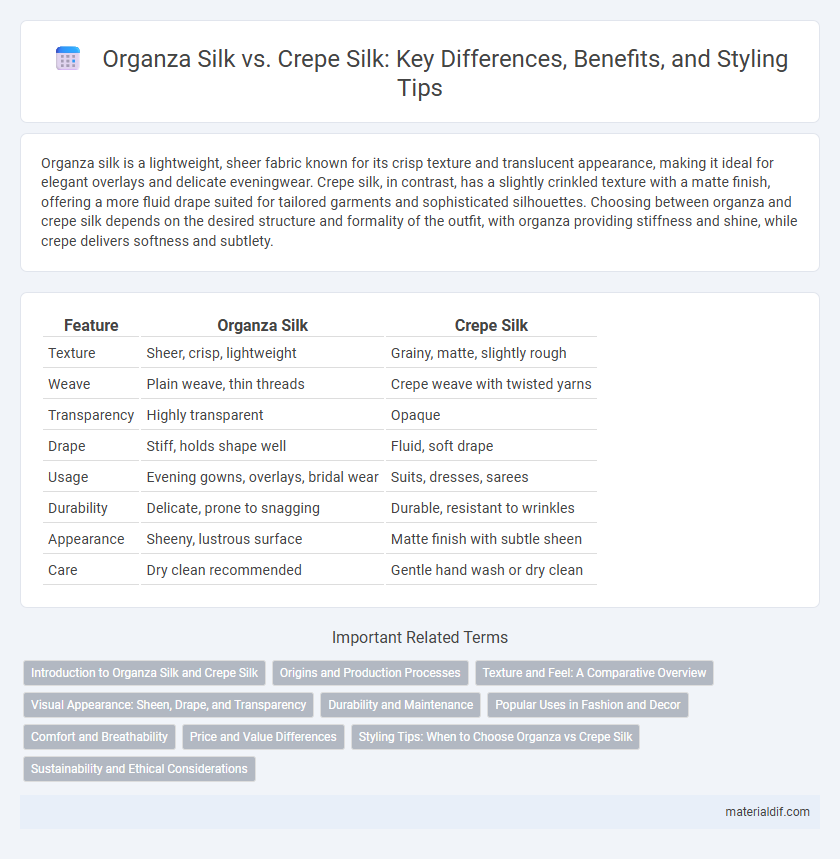Organza silk is a lightweight, sheer fabric known for its crisp texture and translucent appearance, making it ideal for elegant overlays and delicate eveningwear. Crepe silk, in contrast, has a slightly crinkled texture with a matte finish, offering a more fluid drape suited for tailored garments and sophisticated silhouettes. Choosing between organza and crepe silk depends on the desired structure and formality of the outfit, with organza providing stiffness and shine, while crepe delivers softness and subtlety.
Table of Comparison
| Feature | Organza Silk | Crepe Silk |
|---|---|---|
| Texture | Sheer, crisp, lightweight | Grainy, matte, slightly rough |
| Weave | Plain weave, thin threads | Crepe weave with twisted yarns |
| Transparency | Highly transparent | Opaque |
| Drape | Stiff, holds shape well | Fluid, soft drape |
| Usage | Evening gowns, overlays, bridal wear | Suits, dresses, sarees |
| Durability | Delicate, prone to snagging | Durable, resistant to wrinkles |
| Appearance | Sheeny, lustrous surface | Matte finish with subtle sheen |
| Care | Dry clean recommended | Gentle hand wash or dry clean |
Introduction to Organza Silk and Crepe Silk
Organza silk is a lightweight, sheer fabric known for its crisp texture and subtle sheen, often used in evening wear and bridal gowns. Crepe silk features a crinkled or pebbled surface created by twisting threads tightly, providing a distinctive matte finish and fluid drape ideal for dresses and blouses. Both types of silk originate from mulberry silkworms, but differ significantly in weave, texture, and application, making them unique choices in luxury textiles.
Origins and Production Processes
Organza silk originates from China and India, crafted through a labor-intensive weaving process that produces a crisp, sheer fabric with a smooth texture. Crepe silk, commonly sourced from India and Japan, is made using a unique weaving technique combined with high-twist yarns that create a distinctive crinkled, textured surface. The production of organza involves twisting silk threads tightly before weaving, while crepe silk is characterized by its use of highly twisted yarns and specific finishing methods to achieve its signature grainy appearance.
Texture and Feel: A Comparative Overview
Organza silk is lightweight and sheer with a crisp texture that provides a stiff, structured feel ideal for overlays and formal wear. Crepe silk features a grainy, pebbled texture achieved through tightly twisted threads, offering a soft, draped feel perfect for flowing garments and elegant silhouettes. Both fabrics exhibit unique tactile qualities, with organza emphasizing rigidity and transparency, while crepe silk prioritizes softness and fluidity.
Visual Appearance: Sheen, Drape, and Transparency
Organza silk exhibits a crisp, sheer appearance with a high sheen that catches light, creating a shimmering effect ideal for delicate overlays and structured garments. Crepe silk boasts a matte finish with a fluid drape, offering a textured surface that absorbs light softly, resulting in an elegant, understated shine. Transparency in organza silk is pronounced due to its lightweight, open weave, while crepe silk presents a denser, opaque fabric suitable for flowing silhouettes.
Durability and Maintenance
Organza silk is lightweight and delicate, making it less durable and requiring gentle hand washing or dry cleaning to maintain its crisp texture. Crepe silk offers higher durability due to its tightly woven fibers and textured surface, allowing for easier maintenance with occasional dry cleaning and minimal delicate handling. Choosing crepe silk ensures longer-lasting garments with reduced risk of damage compared to the more fragile organza silk.
Popular Uses in Fashion and Decor
Organza silk is prized in fashion for its lightweight, sheer texture, making it ideal for evening gowns, bridal wear, and delicate overlays that require structure without heaviness. Crepe silk's distinctive crinkled surface lends itself well to flowing dresses, blouses, and scarves, offering both elegance and comfort with its matte finish. In home decor, organza silk is commonly used for drapes and sheer curtains that enhance light diffusion, while crepe silk adds texture and visual interest to upholstery and decorative pillows.
Comfort and Breathability
Organza silk is lightweight and sheer, offering excellent breathability ideal for warm climates, while crepe silk has a denser weave that provides more structure but less airflow. The smooth, crisp texture of organza silk enhances comfort during hot weather, whereas crepe silk's slightly rough surface feels warmer and better suited for cooler conditions. Choosing between organza and crepe silk depends on the desired balance of ventilation and fabric weight for optimal comfort.
Price and Value Differences
Organza silk, known for its lightweight, sheer texture, typically commands a higher price due to its intricate weaving process and delicate appearance, making it valuable for luxury eveningwear and bridal attire. Crepe silk, characterized by a crinkled, textured surface, offers a more affordable price point while maintaining durability and versatility suited for everyday fashion and formal occasions. The price difference primarily reflects the production complexity and end-use, with organza silk providing higher perceived value in exclusivity and visual appeal.
Styling Tips: When to Choose Organza vs Crepe Silk
Organza silk, with its crisp texture and sheer appearance, is ideal for evening gowns and formal wear when a structured, voluminous look is desired. Crepe silk, known for its matte finish and fluid drape, is perfect for casual to semi-formal outfits requiring comfort and elegance. Choose organza for dramatic silhouettes and highlight crepe silk for graceful, flowing styles suitable for day-to-night transitions.
Sustainability and Ethical Considerations
Organza silk, known for its sheer, crisp texture, often requires intensive chemical processing that raises sustainability concerns, whereas crepe silk, with its natural matte finish, is typically produced using less water and fewer chemicals, enhancing its eco-friendliness. Ethical considerations in silk production also vary; mulberry silk used for crepe silk commonly involves more regulated sericulture practices, promoting better worker conditions compared to some organza silk variants sourced from wild or less controlled silk farms. Choosing crepe silk supports environmentally responsible manufacturing and aligns with ethical labor standards more consistently than organza silk.
Organza silk vs Crepe silk Infographic

 materialdif.com
materialdif.com